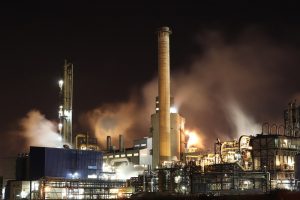The Energy Sector Posting Record Profits
In case you haven’t noticed, the price of gasoline at the pump has been going up lately. According to AAA, a gallon of gasoline is $3.88—its highest level since October 2022.
One reason for the price increase is that the price of crude oil has moved back above the $95-per-barrel level after Saudi Arabia announced further cuts in its oil output. However, there is a more important reason for the move higher in gasoline, diesel, and other mid-distillates: there is a shortage of refinery capacity in both North America and Europe.
This means it’s a great time to be a company that refines oil…
Refiners’ Record Profits
In fact, the International Energy Agency (IEA) said in its last oil market report that refiners were enjoying “near-record profits.” Here is what the IEA said:
A third wave of refinery capacity closures, conversions to biofuel plants and project delays since the pandemic reduced the overhang in global refinery capacity. This, combined with a sharp drop in Chinese oil product exports and an upheaval of Russian trade flows, resulted in record profits for the industry last year (2022).…
Refiners may need to shift their product yields towards middle distillates and petrochemical feedstocks to reflect changing demand patterns. Demand for petroleum-based premium road transport fuels, such as gasoline and diesel, is 1 mb/d below 2019 levels at the end of the forecast period. At the same time, robust petrochemical activity and slower growth in natural gas liquids (NGLs) supply raises demand for refinery-supplied LPG and naphtha…Close alignment with petrochemical plant feedstock needs could leave middle distillate markets very tight by 2028.
So, while we may have some temporary lulls, it looks like the middle distillates markets will remain tight for years to come.
The top U.S. oil refiners planned to run their plants in the third quarter at up to 95% of their combined 17.9 million barrel-per-day capacity, according to industry executives and analysts.
The U.S. refining industry has been running at above 90% of capacity for more than a year on strong gasoline and diesel demand—and high profit margins. Refiners remain optimistic about the ongoing bull run due to projected sustained strong demand growth and low inventory levels. Profit on processing a barrel of crude oil at a typical U.S. refinery has jumped by about a third year to date!
U.S. oil refining companies said, during their second quarter earnings presentations, that strong global demand for fuels and low product inventories are driving robust profits. U.S. distillate fuel oil inventories were 23 million barrels, or 16% below the prior ten-year seasonal average in August. And the deficit to the ten-year average has widened since March and April, putting strong upward pressure on prices.
Add this all up and it’s nirvana for refining companies.
And don’t expect more refining capacity to ever come onstream. There is little appetite in the U.S. to invest in new refining capacity, despite the strong profit margins, as the growing uptake of electric vehicles is expected to eventually cut deeply into demand for fossil fuels.
Refined Investment
There are three large independent refining companies:
Phillips 66 (PSX) is a $54 billion market cap company that owns and operates 13 refineries. Its stock is up 17.7% year-to-date and has a nearly 3.5% dividend yield.
Marathon Petroleum (MPC) has a $61.5 billion market cap and owns and operates 13 refineries. Its stock is up 35% year-to-date and has a 1.95% dividend yield.
Valero Energy (VLO) has a $50.75 billion market cap and owns and operates 15 refineries. Its stock is up 16% year-to-date and has a 2.84% dividend yield.
Of these three, I prefer Phillips 66, which has the highest dividend yield and is the most diversified of the independent refiners. The company benefits from its size, scale, and diversified business portfolio, which includes refining, midstream, chemicals, and marketing and specialty operations. This diversification has made the company’s cash flow less volatile than that of most pure-play refiners.
In June 2023, Phillips 66 completed the acquisition of all publicly held common units of DCP Midstream for $3.8 billion. The company anticipates generating an incremental $1 billion of annual adjusted EBITDA, while expecting to capture over $400 million of synergies across its wellhead-to-market value chain by 2025 from this deal.
Overall, I believe the acquisition will benefit Phillips 66 as it expands its exposure to natural gas and natural gas liquids (NGLs), enabling the company to further diversify its operating segments and possibly helping to insulate its profit margins.
Phillips 66 management has focused its strategy on reallocating refining-generated cash flows to midstream and chemical investments, which can deliver steadier earnings and returns over time, while also setting a high bar for refining reinvestment. The company also has a long history of returning excess cash to shareholders through buybacks and dividends.
In the second quarter of 2023, the company repurchased $1.3 billion in shares and paid out $474 million in dividends. Since the third quarter of 2022, it has returned around $5.4 billion to shareholders in the form of buybacks and dividends and plans to return $10 billion to $12 billion over the 10-quarter period between the third quarter of 2022 through year-end 2024.
Looking ahead, although 2024 refining margins and earnings may not match 2022 record levels, they are likely to remain well above historical levels.
And with one of the highest distillate yields among its peers, Phillips 66 is positioned well for the long term, where the growth outlook for distillate is more favorable than gasoline.
Phillips 66 (PSX) is a buy on any weakness, preferably below $125.
This post originally appeared at Investors Alley.
Category: Dividend Stocks To Buy?





